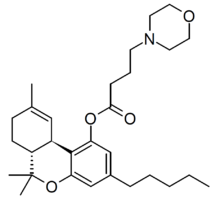Chemistry:THC morpholinylbutyrate
From HandWiki
Short description: Chemical compound
 | |
| Identifiers | |
|---|---|
| |
| CAS Number | |
| PubChem CID | |
| ChemSpider | |
| UNII | |
| ChEMBL | |
| Chemical and physical data | |
| Formula | C29H43NO4 |
| Molar mass | 469.666 g·mol−1 |
| 3D model (JSmol) | |
| |
| |
THC morpholinylbutyrate (SP-111, Δ9-THC-O-[4-(morpholin-4-yl)butyrate]) is a synthetic derivative of tetrahydrocannabinol, developed in the 1970s. It is a prodrug which is converted into THC inside the body, and was one of the first derivatives of THC that is able to form water-soluble salts, giving it a significant advantage over THC for some applications. However, it is less potent than THC and the metabolic conversion to THC is relatively slow and variable, giving it unpredictable pharmacokinetics which has limited its research applications.[1][2][3][4]
See also
References
- ↑ "Effects of delta-9-THC and a water soluble ester of delta-9-THC on schedule-controlled behavior". Pharmacology, Biochemistry, and Behavior 3 (1): 29–32. 1975. doi:10.1016/0091-3057(75)90077-5. PMID 1129353.
- ↑ "The effects of SP-111, a water-soluble THC derivative, on neuronal activity in the rat brain". Brain Research 139 (2): 263–75. January 1978. doi:10.1016/0006-8993(78)90928-9. PMID 624059.
- ↑ "Pretreatment with delta 1-tetrahydrocannabinol and psychoactive drugs: effects on uptake of biogenic amines and on behavior". European Journal of Pharmacology 59 (3–4): 267–76. November 1979. doi:10.1016/0014-2999(79)90290-5. PMID 230975.
- ↑ "delta 9-THC as a discriminative stimulus in rats and pigeons: generalization to THC metabolites and SP-111". Psychopharmacology 71 (3): 281–9. 1980. doi:10.1007/BF00433063. PMID 6256796.
 |

